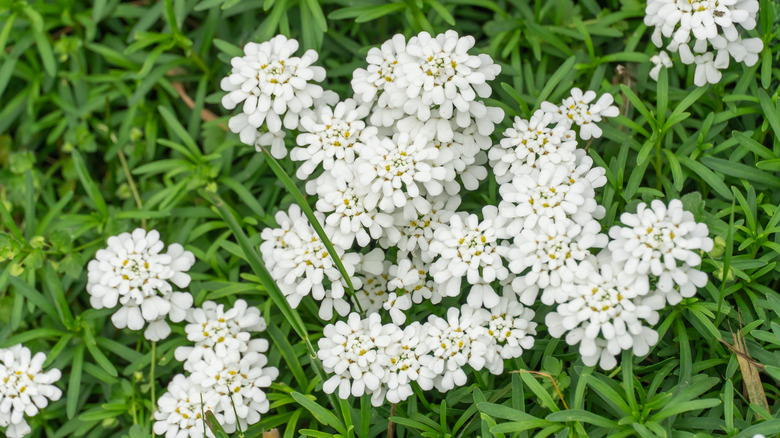The Delicate Flowering Plant That Can Help Block Out Weeds In Your Garden
If you're struggling with weeds in your garden beds, rather than spending all your time down on your hands and knees pulling them out, why not grow some gorgeous flowering ground covers that will help to cover the soil, and block out the sun from reaching those weed seeds so that they can't germinate? One of the most beautiful plants that'll help prevent pesky weeds in the garden is candytuft.
Candytuft is considered a ground cover which means that it spreads to cover the soil entirely with its stems and foliage. By covering the soil and shading it from the sun, the weed seeds aren't able to germinate so weed growth will be limited. Even if some weeds do manage to come through, plants like candytuft that love to spread will outcompete the weeds for the moisture and nutrients in the soil. So, you'll find that you won't have to spend your entire weekend weeding your garden beds if you grow this plant along the borders or even around your existing shrubs. Here's everything you need to know about this lovely ground cover plant, and how to grow it in your garden to stop those pesky weeds from spoiling your impressive landscaping.
Plant characteristics of candytuft
Candytuft (Iberis sempervirens) is a pretty groundcover with the most delicate white flowers. It only reaches a height of around 12 inches but will spread to around 18 inches. It's a herbaceous perennial and can be grown in USDA zones 3 through 8. This lovely low-growing plant will stay green in warmer regions but might die back a little if your winters are cold. Apart from the pretty white flowers that will cover the plant entirely in spring and summer, it has gorgeous leathery leaves that will still add some lushness to your garden after the flowers have finished.
As this plant loves to spread out, the stems will grow roots wherever they touch the soil. This means that new plants can be easily removed from the main clump and planted in other areas in your garden. Candytuft is both drought and salt tolerant so it's perfect for gardens in coastal regions as well. This beautiful early-blooming flower is a must for your spring garden as it blends well with taller growing, spring-flowering bulbs and wildflowers. Plus, it will cover any exposed soil which means weeds won't grow to spoil the look of your stunning flower garden.
Where does candytuft grow best?
Candytuft grows best in full sun but it can tolerate a little shade, although it won't flower quite as profusely. Ideally, you want to plant it where it will receive at least six hours of sunlight daily. This makes it perfect for growing along flower bed borders or beside paths or walkways. It can handle a range of soil types as long as the soil is free-draining and doesn't become waterlogged. Candytuft doesn't handle wet soils well, as this can lead to diseases such as crown rot. It's a good idea to enrich your soil with some compost before planting your candytuft in spring or early fall. If you live in one of the colder regions, mulch the plant by covering it lightly with evergreen boughs to protect it from sun scorch in winter.
Candytuft is a moderate feeder so you should provide your plants with some fairly balanced slow-release fertilizer in spring just as the new leaves start to grow, and then again in early fall to help the plant get through winter. The best time to clip back your candytuft is just after the flowers have finished. This will help to keep it in check and stop it from spilling over onto your paths. Plus, regular clipping will encourage lots of new growth and stop the plant from becoming too woody. Apart from stopping the weeds in your flower beds, candytuft is also a beautiful perennial for a sunny rock garden.


